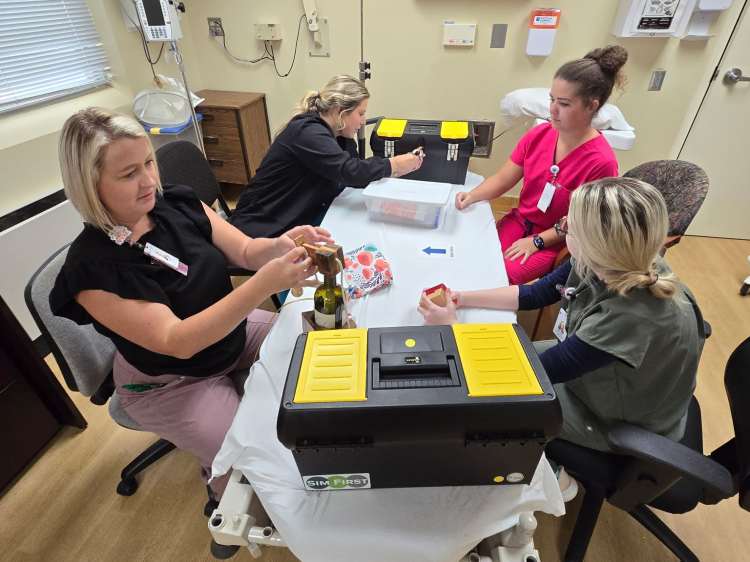Simulation saves lives at Russell Medical Center

When Allyson Garrett stepped into her role as education and employee health nurse at Russell Medical Center in Alexander City in 2022, she was eager to find new ways to prepare her team for the realities of patient care. That’s when her director introduced her to UAB’s Mobile Simulation program.
“We did a demo, and I found the experience valuable,” Garrett recalled. “The tools were great, and Mercedees Willis (mobile simulation coordinator with UAB Clinical Simulation) was wonderful at communicating with people and making them feel at ease. That really set the tone.”
It also set the calendar. Garrett and Willis began scheduling follow-up sessions, starting with a needs assessment to identify the areas at Russell where simulation could have the greatest impact.
Still, not everyone was convinced. Many of Garrett’s staff members had only known simulation in the context of nursing school, where performance could determine a pass or fail.
“At first, employees were hesitant,” Garrett said. “They didn’t want to be graded. So, I encouraged them to participate, and I participated alongside them. I shared my own vulnerabilities and questions during the scenarios, and slowly, they started to open up.”
Now, the transformation is complete. Staff members are comfortable enough to attend sessions without her — and they’re the ones reassuring newcomers.
“They tell new staff, ‘It’s different. You’re not being graded. She’s not going to take your license away,’” Garrett said. “By their second simulation, they’re buying in.”
That buy-in has led to measurable benefits. One of the earliest was the launch of a new PICC line program at Russell.
“We learned how to care for and manage PICC lines,” Garrett said. “Before, only a certain set of staff in the emergency department could do that. Now, multiple departments are able to handle them.”
Simulation has also given staff members hands-on experience with high-risk, low-frequency situations they might not otherwise encounter until a real patient’s life is at stake.
“It’s great to experience those in a safe environment first,” Garrett said.
That growing skill set and confidence have translated into even higher-stakes successes, including a case that stands out for Garrett.
After staff expressed difficulty recognizing placental abruption, UAB Mobile Simulation partnered with Sharon Phelan, M.D., adjunct professor of OB-GYN with UAB Medicine, to develop a scenario tailored for Russell’s maternity unit. During the debrief, Phelan reviewed clinical indicators, while Willis introduced the CUS method (“I’m Concerned, I’m Uncomfortable, this is a Safety issue”) as a communication tool.
Months later, the unit faced a real placental abruption. Armed with their new knowledge and the confidence to speak up, the team acted decisively, saving both mother and baby.
“It made them proud,” Garrett said. “When you engage your staff, perform needs assessments and respond to their requests for training, it improves outcomes. This was proof.”
Beyond clinical skills, Garrett sees simulation building camaraderie.
“A lot of issues in health care come down to communication,” she said. “When someone feels comfortable speaking up, patient outcomes improve—and so does teamwork.”
For anyone hesitant about simulation, Garrett’s message is simple: Try it.
“Immerse yourself before making a decision,” she added. “It has a profound effect on patient care.”
To learn more about UAB Mobile Simulation, visit here.
UAB Medicine’s Clinical Simulation program offers opportunities for individuals and teams across UAB Medicine and beyond to practice before they deliver care. The UAB Mobile Simulation program is part of the services offered through the Alabama Rural Health Collaborative (ARHC) We encourage all who provide and support patient care to “Sim First.” Together, we can put our patients’ safety first.




0 Comments